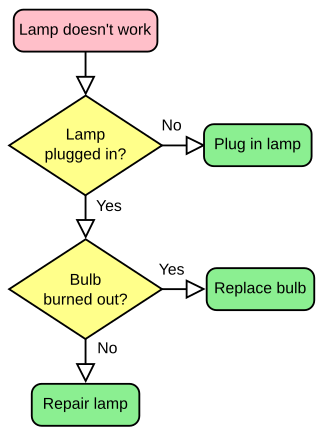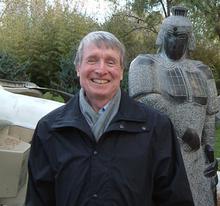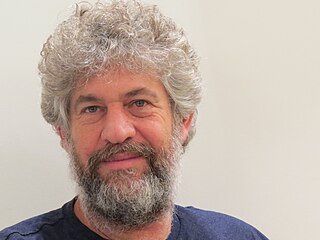
In mathematics and computer science, an algorithm is a finite sequence of mathematically rigorous instructions, typically used to solve a class of specific problems or to perform a computation. Algorithms are used as specifications for performing calculations and data processing. More advanced algorithms can use conditionals to divert the code execution through various routes and deduce valid inferences.

Kruskal's algorithm finds a minimum spanning forest of an undirected edge-weighted graph. If the graph is connected, it finds a minimum spanning tree. It is a greedy algorithm that in each step adds to the forest the lowest-weight edge that will not form a cycle. The key steps of the algorithm are sorting and the use of a disjoint-set data structure to detect cycles. Its running time is dominated by the time to sort all of the graph edges by their weight.

Ronald Linn Rivest is an American cryptographer and computer scientist whose work has spanned the fields of algorithms and combinatorics, cryptography, machine learning, and election integrity. He is an Institute Professor at the Massachusetts Institute of Technology (MIT), and a member of MIT's Department of Electrical Engineering and Computer Science and its Computer Science and Artificial Intelligence Laboratory.

Peter Williston Shor is an American theoretical computer scientist known for his work on quantum computation, in particular for devising Shor's algorithm, a quantum algorithm for factoring exponentially faster than the best currently-known algorithm running on a classical computer. He has been a professor of applied mathematics at the Massachusetts Institute of Technology (MIT) since 2003.
Bio-inspired computing, short for biologically inspired computing, is a field of study which seeks to solve computer science problems using models of biology. It relates to connectionism, social behavior, and emergence. Within computer science, bio-inspired computing relates to artificial intelligence and machine learning. Bio-inspired computing is a major subset of natural computation.

A flowchart is a type of diagram that represents a workflow or process. A flowchart can also be defined as a diagrammatic representation of an algorithm, a step-by-step approach to solving a task.
In genetic algorithms (GA), or more general, evolutionary algorithms (EA), a chromosome is a set of parameters which define a proposed solution of the problem that the evolutionary algorithm is trying to solve. The set of all solutions, also called individuals according to the biological model, is known as the population. The genome of an individual consists of one, more rarely of several, chromosomes and corresponds to the genetic representation of the task to be solved. A chromosome is composed of a set of genes, where a gene consists of one or more semantically connected parameters, which are often also called decision variables. They determine one or more phenotypic characteristics of the individual or at least have an influence on them. In the basic form of genetic algorithms, the chromosome is represented as a binary string, while in later variants and in EAs in general, a wide variety of other data structures are used.

Erik D. Demaine is a Canadian-American professor of computer science at the Massachusetts Institute of Technology and a former child prodigy.

Charles Eric Leiserson is a computer scientist and professor at Massachusetts Institute of Technology (M.I.T.). He specializes in the theory of parallel computing and distributed computing.

John Henry Holland was an American scientist and professor of psychology and electrical engineering and computer science at the University of Michigan, Ann Arbor. He was a pioneer in what became known as genetic algorithms.

Clifford Seth Stein, a computer scientist, is a professor of industrial engineering and operations research at Columbia University in New York, NY, where he also holds an appointment in the Department of Computer Science. Stein is chair of the Industrial Engineering and Operations Research Department at Columbia University. Prior to joining Columbia, Stein was a professor at Dartmouth College in New Hampshire.

Introduction to Algorithms is a book on computer programming by Thomas H. Cormen, Charles E. Leiserson, Ronald L. Rivest, and Clifford Stein. The book is described by its publisher as "the leading algorithms text in universities worldwide as well as the standard reference for professionals". It is commonly cited as a reference for algorithms in published papers, with over 10,000 citations documented on CiteSeerX, and over 67,000 citations on Google Scholar as of 2023. The book sold half a million copies during its first 20 years, and surpassed a million copies sold in 2022. Its fame has led to the common use of the abbreviation "CLRS", or, in the first edition, "CLR".
Neural network software is used to simulate, research, develop, and apply artificial neural networks, software concepts adapted from biological neural networks, and in some cases, a wider array of adaptive systems such as artificial intelligence and machine learning.
Thomas H. Cormen is an American politician and retired academic. He is the co-author of Introduction to Algorithms, along with Charles Leiserson, Ron Rivest, and Cliff Stein. In 2013, he published a new book titled Algorithms Unlocked. He is an emeritus professor of computer science at Dartmouth College and former chairman of the Dartmouth College Department of Computer Science. Between 2004 and 2008 he directed the Dartmouth College Writing Program. His research interests are algorithm engineering, parallel computing, and speeding up computations with high latency. In 2022, he was elected as a Democratic member of the New Hampshire House of Representatives.

In the mathematical and algorithmic study of graph theory, the converse, transpose or reverse of a directed graph G is another directed graph on the same set of vertices with all of the edges reversed compared to the orientation of the corresponding edges in G. That is, if G contains an edge (u, v) then the converse/transpose/reverse of G contains an edge (v, u) and vice versa.
Leabra stands for local, error-driven and associative, biologically realistic algorithm. It is a model of learning which is a balance between Hebbian and error-driven learning with other network-derived characteristics. This model is used to mathematically predict outcomes based on inputs and previous learning influences. Leabra is heavily influenced by and contributes to neural network designs and models, including emergent.
Cognitive musicology is a branch of cognitive science concerned with computationally modeling musical knowledge with the goal of understanding both music and cognition.

Noam Nisan is an Israeli computer scientist, a professor of computer science at the Hebrew University of Jerusalem. He is known for his research in computational complexity theory and algorithmic game theory.
In computer science, the analysis of parallel algorithms is the process of finding the computational complexity of algorithms executed in parallel – the amount of time, storage, or other resources needed to execute them. In many respects, analysis of parallel algorithms is similar to the analysis of sequential algorithms, but is generally more involved because one must reason about the behavior of multiple cooperating threads of execution. One of the primary goals of parallel analysis is to understand how a parallel algorithm's use of resources changes as the number of processors is changed.












